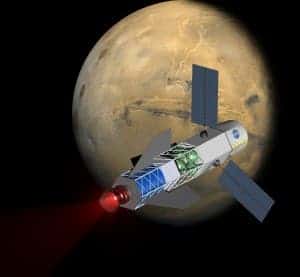
A concept image of a spacecraft powered by a fusion-driven rocket. In this image, the crew would be in the forward-most chamber. Solar panels on the sides would collect energy to initiate the process that creates fusion. (c) University of Washington
Billions of dollars and decades worth of research have been invested in fusion propelling technology, so that one day we might breach current spaceflight limitations that offer little hope of straying too far from our planet. Researchers at Washington University have recently made great strides forward in this respect and have successfully tested each stage of their fusion rocket in the lab so far. If they manage to combine all the stages to work together then spaceflight will be in for nothing short of a revolution. For instance, uing a fusion powered rocket a trip to Mars would only take 30 days compared to years using current technology.
The team of scientists, led by John Slough, have been working for the past few years on an unique solution of manipulation nuclear fusion and so far their tests of individual stages have proven successful in the lab. The next step is to combine these isolated stages into a working fusion rocket, but to achieve this they need to generate more power than the fusion process requires for kickstart – a feat that is a lot more difficult than it sounds since it hasn’t been achieved not even to this day, despite 60 years worth of research and billions invested.
What makes fusion rockets particularly appealing is their immense energy density – 7 million times more dense than conventional rocket fuel. This means that you can build not only more powerful rockets – powerful enough to make a trip to Mars in a mere 30 days at 200,000 miles per hour – but lighter ones as well, significantly reducing cost.
“Using existing rocket fuels, it’s nearly impossible for humans to explore much beyond Earth. We are hoping to give us a much more powerful source of energy in space that could eventually lead to making interplanetary travel commonplace,” Slough was quoted by the university as saying.

The fusion driven rocket test chamber at the UW Plasma Dynamics Lab in Redmond. The green vacuum chamber is surrounded by two large, high-strength aluminum magnets. These magnets are powered by energy-storage capacitors through the many cables connected to them. (c) University of Washington
New age of space travel once fusion rockets kick in
The technology basically relies on a sort of plasma encased in its own magnetic field which when compressed produces nuclear fusion, similar to how diesel engines compress diesel fuel to produce combustion. The plasma is deuterium-tritium (hydrogen isotopes) and this is surrounded by metal rings of lithium. At the right time when the plasma reaches a certain points in the combustion chamber, a magnetic fields acts and causes the rings to compress the plasma. The force of implosion is so immense that the metal rings cause the plasma to compress into nuclear fusion. The metal rings would be ejected out of the rocket at 67,000 mph (108,000 kmh), generating thrust in a process that is repeated every 10 seconds allowing the rocket to accelerate somewhere around 200,000 miles per hour. This is the plan and so far only each individual stage taken separately have been tested.
Their work is really cut out for them, since, again, they need to solve the energy problem – producing more energy than it is pumped to kickstart the reaction and then maintaining this reaction. It’s the later that causes so many hurdles; starting nuclear fusion isn’t that difficult, maintaining and then converting the thermal energy into electrical current is something that hasn’t be achieved yet. Yet, the Washington University researchers work seems promising enough.
Most likely, however, they won’t be able to finish a working fusion rocket, if ever, any time soon. Not in time for Dennis Tito’s 2018 manned expedition to Mars, slated to last 500 days. For more about fusion rockets work check the video below.
The project is funded through NASA’sInnovative Advanced Concepts Program. Last month at a symposium, Slough and his team from MSNW, of which he is president, presented their mission analysis for a trip to Mars, along with detailed computer modeling and initial experimental results









